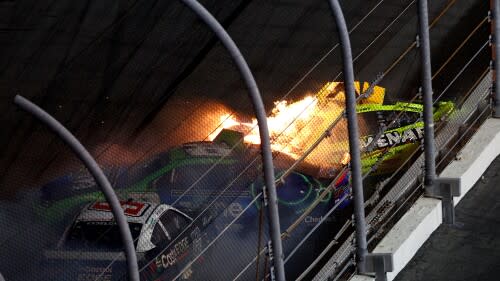Ryan Blaney moving forward after 'frustrating' Daytona 500 qualifying race crash
DAYTONA BEACH, Fla. — After a 55 G-force impact Thursday at Daytona that left Ryan Blaney sore and fuming, the reigning Cup champion says he does not plan to talk those who sparked that crash that crumpled his No. 12 Team Penske Ford and forced him to a backup car for the Daytona 500.
"I've looked at the replays, that's all I needed to see," Blaney said Saturday at Daytona International Speedway. "I'm not going to call out anybody. I was just frustrated getting hooked in the right rear multiple times."
After the crash in Thursday's qualifying race, Blaney said he was “pissed” five times within 16 seconds when voicing frustrations with how other drivers pushed.
Long: Jimmie Johnson, Ryan Blaney experience Daytona’s roller coaster of emotions
Jimmie Johnson felt Daytona’s angst before rejoicing, while Ryan Blaney was upset.
The crash occurred with 12 laps remaining in the second qualifying race. The top line bunched up and a push spun William Byron into the right rear of Blaney's No. 12 Ford. The contact turned Blaney into the outside wall.
Blaney confirmed that Thursday's hit was 55 Gs. He said his crash at Daytona last August was 70 Gs. He gets this data through a mouthpiece developed by Wake Forest School of Medicine, one that collects on-track driver head kinematics and provides researchers with a way to study the impact of crashes on drivers.
Blaney said he's worn the optional mouthpiece since last June at Nashville — after Blaney hit a section of wall not protected by a SAFER barrier.
"I feel like the Nashville hit was by far the hardest hit I've ever taken," Blaney said. "I did not have a mouthpiece in for that. I had one in for the other two (crashes).
"The mouthpiece data is really good for us to see because you have the black box data from the car. But that's just showing the car G load and impact. The important one is what does the driver feel — not the most important — but it's a huge part of the equation."
He said he woke up Friday "over the frustration part" and that his attention turned to helping his team figure out where the backup car needs to be and how they needed to develop strategy for the Daytona 500.
It's not the actual pushing that frustrated Blaney Thursday night. He knows that is a crucial part of superspeedway racing. Blaney even works with spotter Tim Fedewa to get information about the gaps between his car and the car directly in front of him, as well as the next car in line.
The issue for Blaney is the timing of the pushes. Both of his Daytona crashes occurred after pushes in the tri-oval, a section on the frontstretch where there is a lateral load on the car.
Blaney said that he saw on the replay that Brad Keselowski pushed Kyle Busch into William Byron instead of letting him go early enough in the run. Busch had too much speed before hitting Byron in the tri-oval.
"I push people hard but I try to take care of people," Blaney said. "As the pusher you are responsible for the guy in front of you. You have just as much responsibility to make sure that you don't shove the guy in front of you through somebody.
"But you have to understand where you have to let them go. If you are the third car in line, you have to let the second place car in line go. You can't just shove them through the guy leading the top lane because then it gets (to be) bumper cars and then that's when people get turned."
Knowing the best time to push can help limit the potential for multi-car wrecks at Daytona. So can working with the spotter to manage the gaps between each car in line.
This doesn't fully erase the problem. There are other factors that play a role in superspeedway races.
The drivers have limited visibility in the car, so they may not see someone further up the line reducing their speed. There is a lag between the spotter seeing something on the track and communicating it over the radio to the driver.
"I find myself watching race film and playing like the Monday morning quarterback," Keselowski said Saturday. "'He should have made this move, this move' when I evaluate myself but it's just way different in the car."
Keselowski noted that one of the biggest factors in successfully pushing on superspeedways is how each car on the track is handling. He pushed teammate Chris Buescher through the Daytona tri-oval last August. The result was the RFK Racing cars finishing first and second to close out the regular season.
Keselowski also pushed Carson Hocevar through the Talladega tri-oval in last season’s playoff race. This time, that car spun and started a wreck that collected multiple cars.
"There's no way I can know how everybody's car drives and what level of control they're gonna be able to have over it," Keselowski said. "So you try to build up experience and this whole kind of database to make decisions, but then there's just unknowns."

